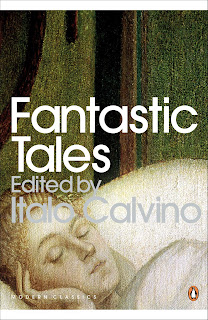Fantastic Tales: Visionary and Everyday edited by Italo Calvino (1983)
This collection deserves pride of place on the anthology shelf next to Kirby McCauley, David G. Hartwell, Hugh Lamb, and Borges. All the tales are essential and canonical, and few have appeared regularly in US and UK collections.
The Beautiful Vampire by THÉOPHILE GAUTIER
....From that night onward my nature was in some way doubled; there were within me two men, neither of whom knew the other. Sometimes I thought I was a priest who dreamed every night that he was a nobleman, sometimes that I was a nobleman who dreamed that he was a priest. I could no longer distinguish dreams from real life; I did not know where reality began and illusion ended. The dissolute, supercilious young lord jeered at the priest, and the priest abhorred the dissipations of the young lord. Two spirals, entwined and confused, yet never actually touching, would give a good idea of this two-headed existence of mine.
Editor Calvino sings the story's canonic praises:
....The temptation of Romuald, the newly ordained priest who meets the beautiful Clarimonde; the vision of the city from the towers above, with the palace of the courtesans illuminated by the sun; the life of penitence in the distant parish until a servant on horseback summons Romuald to give Clarimonde the last rites; love with the dead woman; the uncertainty as to whether the dream is his days as a poor priest or his nights in Renaissance orgies; the discovery that Clarimonde is a vampire who drinks her lovers blood: there are so many great passages that create a tradition. A tradition as well in second-class literature and film: for instance, the exhumation of Clarimonde's cadaver, intact in its coffin and with blood on its lips, that suddenly turns into a skeleton.
***
The Venus of Ille by PROSPER MÉRIMÉE
....The hair, which was raised off the forehead, looked as if it had been gilded at some time. The head was small, like those of nearly all Greek statues, and bent slightly forward. As for the face, I should never be able to express its strange character; it was of quite a different type from that of any other antique statue I could remember. It was not at all the calm and austere beauty of the Greek sculptors, whose rule was to give a majestic immobility to every feature. Here, on the contrary, I noticed with astonishment that the artist had deliberately set out to express ill-nature raised to the level of wickedness. Every feature was slightly contracted: the eyes were rather slanted, the mouth turned up at the corners, and the nostrils somewhat distended. Disdain, irony, cruelty, could be distinguished in that face which was, notwithstanding, of incredible beauty. Indeed, the longer one looked at that wonderful statue, the more distress one felt at the thought that such a marvellous beauty could be united with an utter absence of goodness.
***
The Holes in the Mask by Jean Lorrain (1895)
Not similar to, but echoing L.P. Hartley's sublime tale "Cotillion."
....What if I were like them, what if I too had ceased to exist, and what if beneath my mask there was nothing, only nothingness! I ran to one of the mirrors. A dream figure rose before me, covered in dark green, crowned with black fleurs-de-lis, wearing a silver mask.
I was that masked figure, because I could recognize my gesture in the hand that raised the cowl, and, openmouthed with terror, I let loose an enormous shriek, because there was nothing under the mask of silvered fabric, nothing under the oval of the hood, only the hole of rounded cloth over the empty space. I was dead, and I …
"You've been drinking ether again," grumbled De Jacquels' voice in my ear. "A curious way to while away your boredom as you waited for me!"
Jay
23 May 2020

No comments:
Post a Comment